
- How to Teach

How to Teach Soccer
When teaching Soccer in Physical Education lessons, it is helpful to have a range of activities, teaching models and styles in the toolbox to help ensure students make great progress. Soccer lessons can be delivered in a range of ways depending upon the age, group size, resources available and your level of knowledge of the game.
If teaching lower Elementary (Primary/KS1) you may want to opt for more cooperative group activities where students can explore the different skills without the pressures of any defenders. Slowly you can then begin to bring defenders into whole-group actvities. For upper Elementary (Primary/KS2) students can experience a range of competitive, cooperative, and small-sided games (5-a-side/7-a-side). Once students move into Middle-School (KS3) and High-School (KS4 & 5) this is where students can begin to experience larger-scale (9-a-side) and full-scale (11-a-side) versions of the game. A great way to do this would be using a ‘Teaching Games for Understanding’ model.
Below are a few Soccer activities, example skill card and teaching considerations taken from the ‘Full Soccer Pack’ that you can use in your lessons.
Activity: Traffic Lights
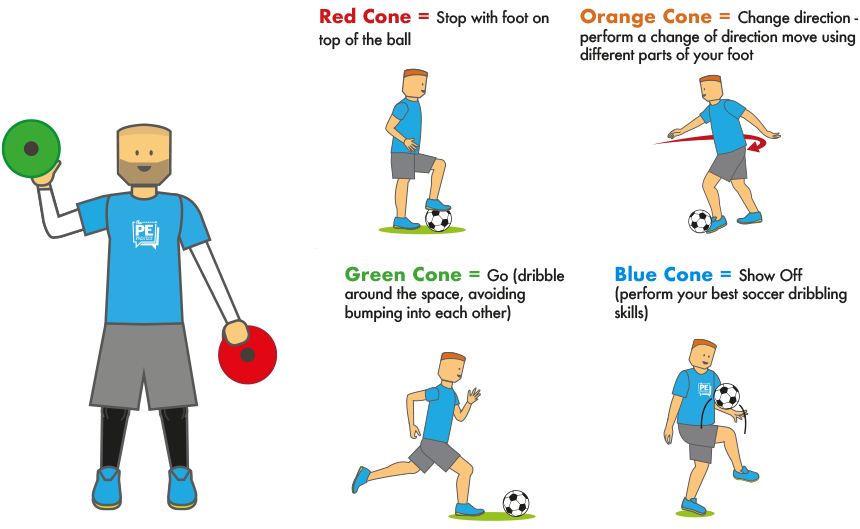
- EQUIPMENT: 1 x soccer ball per student 4 cones for the teacher (red, orange, green, blue)
- SPACE: Large open space
- DURATION: 3-8 mins
- GROUPINGS: Whole Class
Description: Students have a soccer ball each and must respond to the signals (colored cones) that are held up by the teacher. The signals are: Red Cone = Stop with foot on top of the ball; Orange Cone = Change direction - perform a change of direction move using different parts of your foot Green Cone = Go (dribble around the space, avoiding bumping into each other) Blue Cone = Show Off perform your best soccer dribbling skills).
To progress, teacher can challenge students by holding up two cones at a time e.g., Red and Orange = Stop and turn with the ball.
Teaching Points
- Every two touches, head up
- Use different parts of your foot
- Accelerate into space
- Practise using strong and weak foot
- Why should we lift our head up when dribbling?
- How many different ways can you change direction?
Activity: 4v1 Square
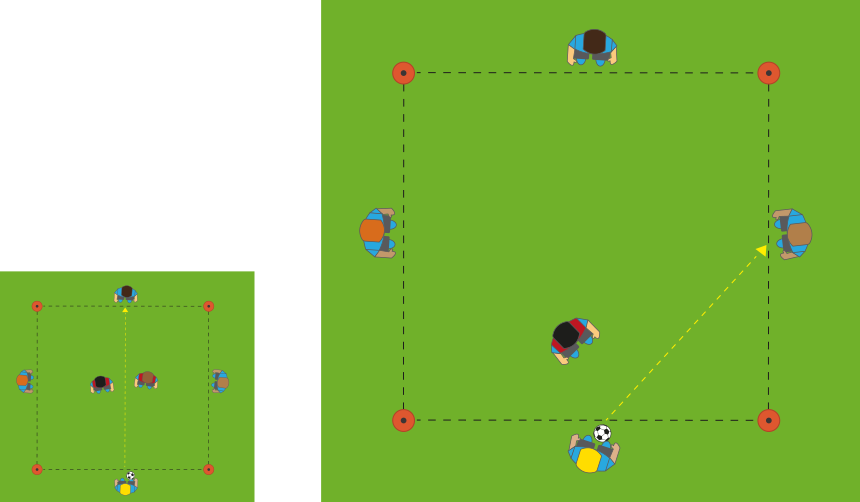
- EQUIPMENT: 1x ball, 4x cones per group
- SPACE: 25’x25’ square (approx.)
- DURATION: 5-10 mins
- GROUPINGS: 5's
Description: Set up four cones to mark out a square. One player is the defender and begins in the middle of the square. The other four players (passers) must stand outside on one-side of the square each (see diagram). Passers must stay on the same side of the square and can’t go inside, and the defender can move freely inside but is not allowed outside. The passers aim is to make consecutive passes in a row without their passes being intercepted. Whilst the defender is trying to intercept as many passes as possible. Passers are allowed to move to improve their passing and receiving angles, but must stay on their side. Change the defender after every intercepted pass, or every 60-90s.
Progression: Same game but now in groups of 6, with 2 defenders in the middle. You can introduce a ‘killer pass’, which is when the ball is passed successfully between two staggered defenders.
- Use the push pass for most passes (inside of foot)
- Explore passing with inside, instep, and outside of feet
- Step into your pass to improve pace and reduce the risk of getting intercepted
- What does a good pass look like?
- Which parts of your feet can you pass with?
- Why is stepping into your pass important?
Activity: Shooting Progressions
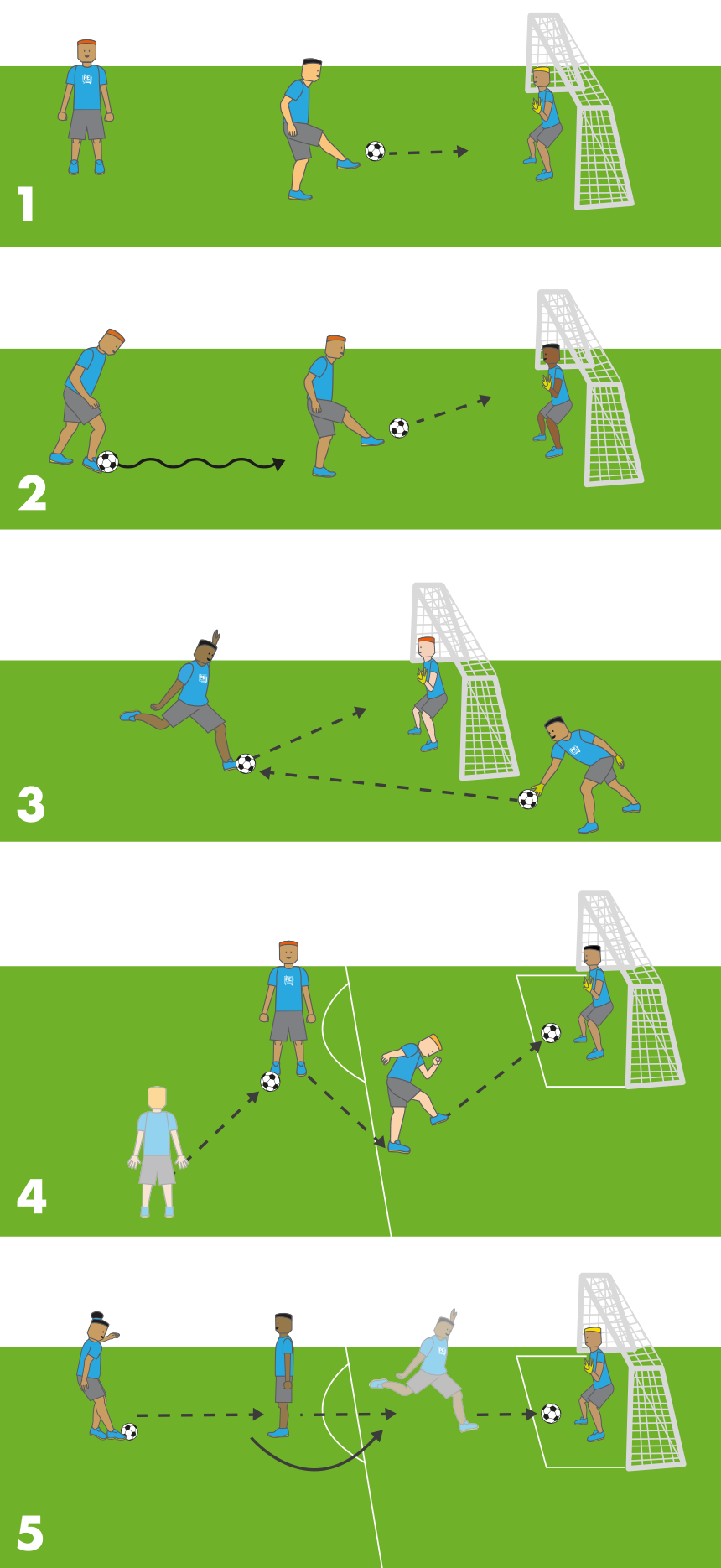
- EQUIPMENT: Soccer balls (1x per pair/group), mini goals
- DURATION: 4-10 mins
- GROUPINGS: 2-6's
Description: Depending upon the number of goals and space available, split the class into small groups or even partners. Have students take turns shooting at a goal following this sequence of progressions: Stage 1) Stationary shooting - like taking a penalty, have students practice shooting the ball from different angles; Stage 2) Dribble & Shoot - have students dribble for 2-5 touches before taking a shot; Stage 3) Ball rollout - have partner stand behind goal line and roll the ball out to shooter. Shooter controls and shoots the ball with one or two touches; Stage 4) Give and Go - shooter starts by passing the ball to a teammate (standing just outside of the box), and then runs towards the goal where the ball is passed back to them, and then shoots; Stage 5) Turn and Shoot - shooter begins without the ball, in the middle, outside the box. Passer pushes the ball into space, shooter must time their turn, control the ball and shoot.
All of these games can be played with and without a goalkeeper. Shooters should aim to score in one of the four corners of the goal.
- Non-kicking foot pointing at target area
- Step into each shot
- Practice shooting with different striking techniques
- What does a good shooting technique look like?
- Where are the best angles to shoot from? Where are the worst?
- Why is shooting quickly important? How many touches might you get in a game?
Skill Card: Instep Pass - Instep Drive
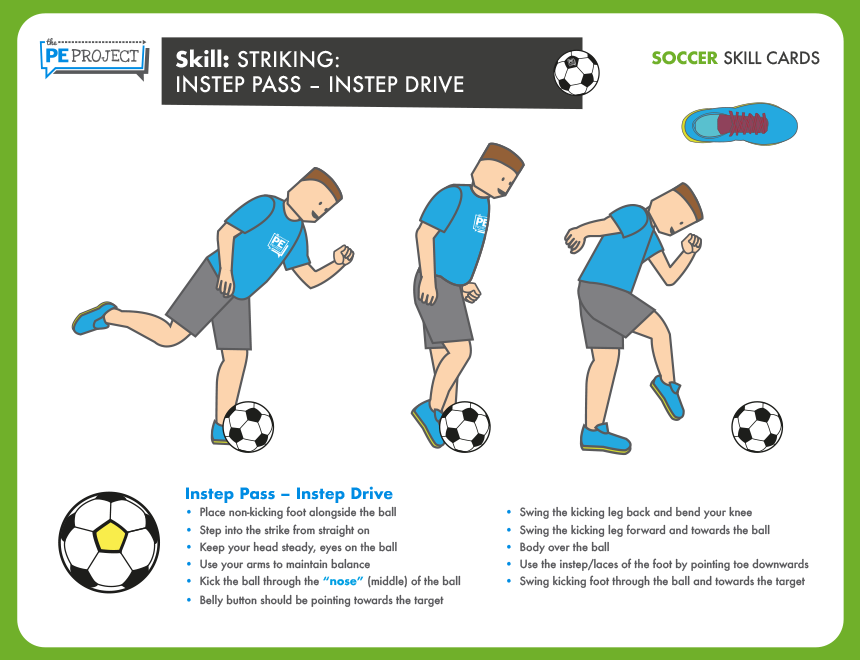
Skill Cards: When teaching Soccer it can be extremely useful for students to use skill cards to deepen their understanding of skill techniques. For example, when trying to teach students how to execute a Instep Pass/Drive they could use the above skill card to learn about the technique with a partner. Then they can take turns practicing the skill whilst their partner observes and gives feedback. This is an example of a 'Reciprocal Teaching Style' which you can learn more about in our 'Teaching Styles' article.
Teaching Considerations
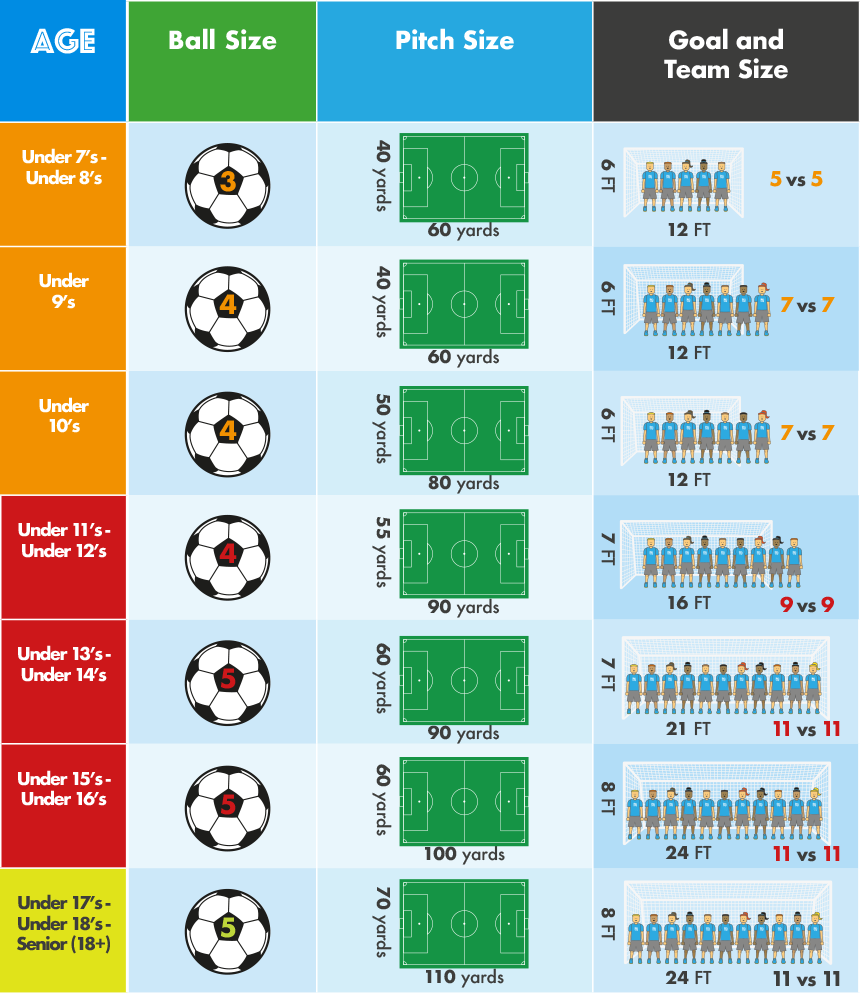
Teaching Considerations: When teaching soccer to children it is important to consider: What grade are they in? What size ball should they use? The size of the pitch? Team size? We hope that the above table will help you answer those questions quickly and confidently.
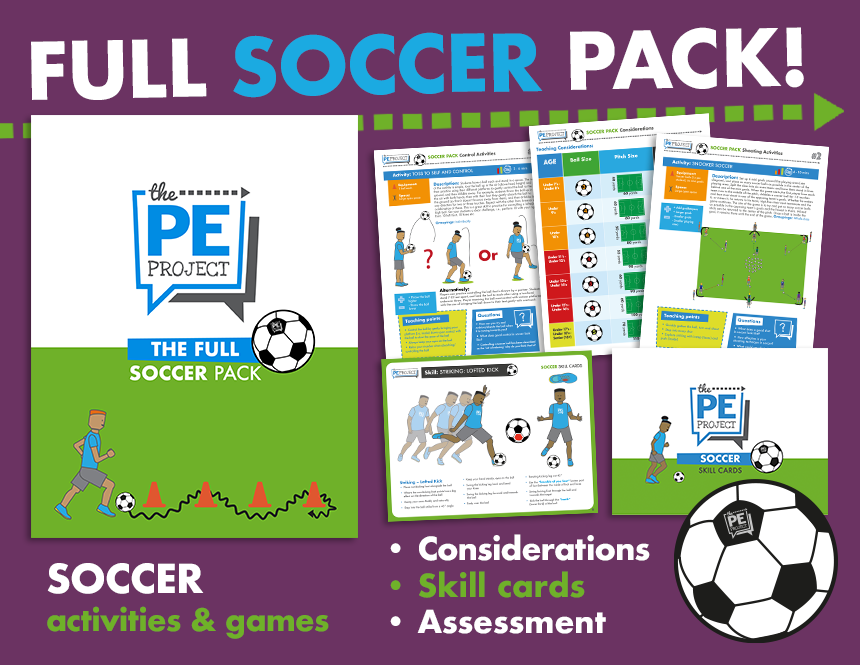
Would you like more Soccer activities? If so, then this pack is for you! It has been developed by highly-qualified and experienced PE teachers for specialists and non-specialists alike who want to deliver fun, engaging Soccer lessons where students can make exceptional progress.
In the Full Soccer Pack by the PE Project you will find:
- Lots of Soccer activities
- Skill Cards
- Assessment Criteria for Elementary, Middle-School, and High-School
- Plus lots of additional extras like questions, teaching recommendations, differentiation strategies.
The Full Soccer Pack
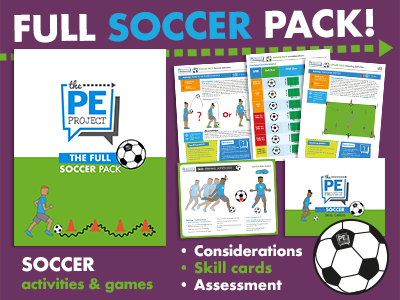
Follow us on Twitter

Follow us on Facebook

Follow us on Instagram

Free Tennis activities for your Phys Ed. lessons.

Free Basketball activities for your Phys Ed. lessons.

Free Track & Field activities for your Phys Ed. lessons.

Free Volleyball activities for your Phys Ed. lessons.

Free FMS activities for your Phys Ed. lessons.

Free Fitness activities for your Phys Ed. lessons.
- Skip to main content
- Skip to footer
Additional menu

The PE Specialist
Awesome Resources for Physical Education Teachers
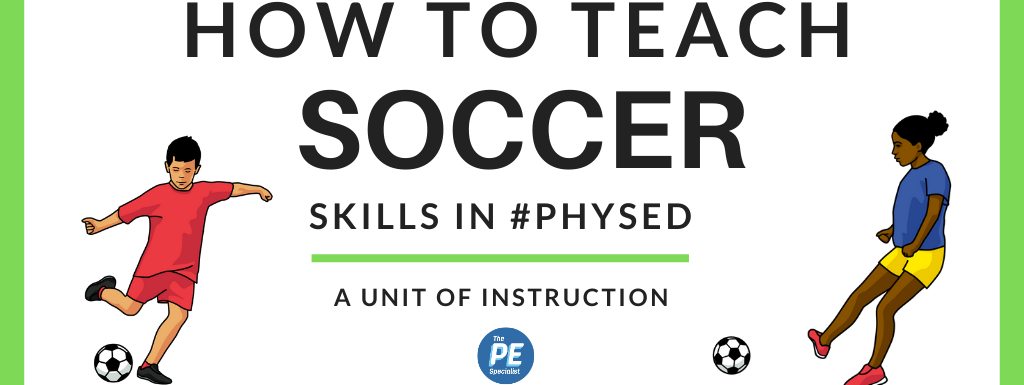
How to Teach a Soccer Unit in PE Class
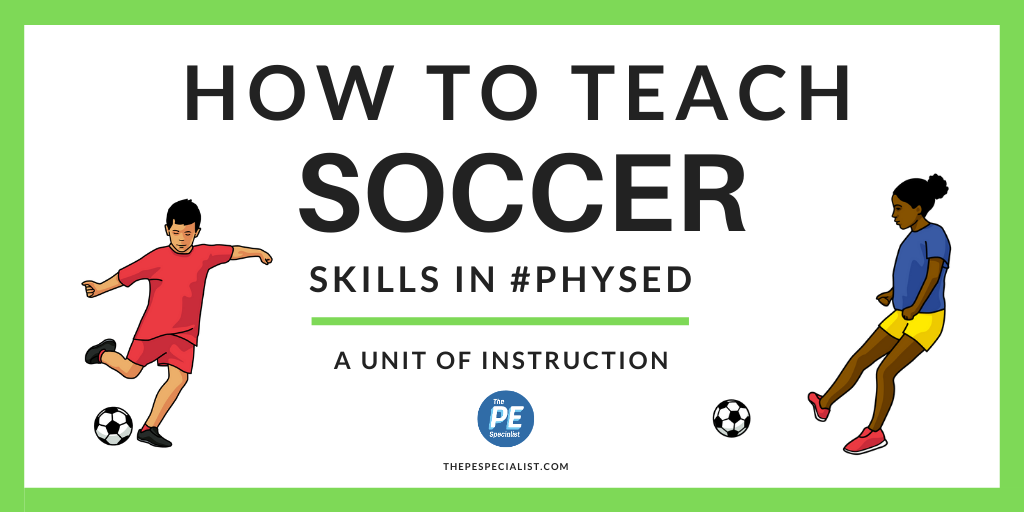
What’s Up PE Fam!
In this post I want to share with you some of my favorite soccer activities and also share some awesome resources we’ve created to help you plan an awesome soccer unit yourself!
Why Soccer?
According to the internet (Dr. Google that is), Soccer is the most popular sport in the entire world. It’s also super accessible for most kids regardless of economic status. All you need is a patch of grass (or dirt) a ball and a couple objects to mark a couple of goals and boom, you can play a soccer game with your friends.
So if you’re considering what subjects to teach in your PE curriculum, I’d say for those 2 reasons (popularity and accessibility) Soccer should be up there on your list.
One of the main reasons I teach soccer each year is because we have 2 soccer goals on our recess playground and it’s a pretty popular sport in our area. When planning my yearly curriculum I try to pick the subjects that I think will have the most “bang for their buck” with my students.
I ask myself what skills are most relevant and most likely be used by the students. Because of the student interest in soccer, the global popularity, the accessibility and opportunity for my students to play daily at recess, I think it’s an important skill set to give my students.
Below you’ll find a few videos from one of my soccer units that I hope help you get a visual of some of the games and activities I use to teach my students the skills for soccer.
Soccer Unit vs Kicking Unit
If you’re in the “Kicking Unit” camp, over the “Soccer Unit” camp – I totally understand and respect that.
I honestly don’t really think it matters too much what you call it, but the reason I choose to brand my units with the sport name is explained in the post below:
View this post on Instagram A post shared by Ben Landers (@thepespecialist)
Soccer Unit Intro
We always kick things off by getting back to the why – as a student I always appreciate teachers explaining to me WHY we are learning something, so I do my best to explain that to students anytime we start a new unit.
I also go over my expectations on management and my start and stop signal so we can quickly transition between each task and not waste any time ?
*Sidenote: The follow the leader footwork video mentioned is one of the videos included in our FTL Soccer Pack which is linked up at the bottom of this post.
I also usually try to “Hook” my students at the beginning of the unit by showing them a super cool youtube video of a professional player so they will be motivated to do their best to improve their skills – there are tons on youtube, but below is an example:
Practicing Footwork
I throw in some Footwork Ladder Drills into our Daily Warmup Routine to kick things off for our soccer unit.
We start the unit by working on some stationary soccer skills using a Follow the Leader Style format to practice our footwork and try to keep our Eyes Up and Use Soft Touches and Close Control throughout the Soccer Unit. I normally use my Soccer Follow the Leader Videos or Animated GIF Slideshow for this, but sometimes I just take the kids through it myself as well.
When everyone has had some practice and is warmed up, we start dribbling around in open space and work on staying inside the boundary lines and keeping the ballin control.
Teaching Shielding with Bumper Ball
With my older students I also teach them the concept of “Shielding” which is the term used to describe how you protect a ball in a soccer game. After explaining it to them we practice shielding the ball with a fun game I call Bumper Ball, check it out below.
So to summarize, I usually go around myself and practice “warm defense” so students can work on shielding the ball from me. I also sometimes pick a few students to help me out and become a “bumper” to play warm defense (especially with a large class or double classes, I would recommend getting some students to help)
If your soccer ball goes out of bounds in a game it’s a Turn Over (we are building in some of the actual rules of soccer into our modified games), so I tell students they need to earn their way back into the game by doing 5 exercises of their choice (Squats, Pushups or Curl ups).
The Partner Bridge Challenge (or “Meg Challenge”)
Another really fun activity and a great way to practice dribbling with control and also have some teachable moments with your students about goal setting and practice is a game I call the Partner Bridge Challenge or The Meg Challenge, you can check it out below:
As you can see this is a really great way to differentiate instruction for your students and challenge all kids no matter where their skill level is – in order to “Hit the Wow” ( related to our Daily Self Assessment ) kids have to beat their own score during the first round.
I love it watching kids get motivated to try and beat their score and then having a great discussion about practice, and how doing something twice will make it easier the second time around. It’s also a great time to talk about the power of a goal – since kids had a specific goal in their mind during the 2nd round it really helps motivate them to give their 100% in order to beat their score.
You can see another example of the activity below:
Passing with the insides of our Feet
Nothing fancy here, we just work on passing a ball with control using the insides of our feet. I explain to the kids that we should NEVER use our toes to kick the ball, since our toes are pointed that would cause us to lose control of the ball (and also possibly injure ourselves).
We get some practice using the insides of our feet to pass the ball with a partner
Soccer Noodle Tag
Once we’ve got the basics down we play some fun modified games to practice our skills in an open environment.
A fun game to work on foot dribbling and passing is soccer noodle tag, it’s a fun variation of Fire and Ice Tag that works great for practicing the skill of finding open space and also controlling the ball while dribbling and passing to a teammate, you can see me explain it below:
*Here’s an overview of Noodle Dance Tag if your interested
You might recognize this one, because I’ve blogged about this activity before – If you want to try it out you can check out more details and download a free lesson plan below:
Soccer Station Activities
If you’ve read many of my posts or follow me on social for a while, you’ll know I’m all about some station activities, especially for my K-1st Kiddos.
I always implement some station work with my younger students during our soccer unit to maximize the time they have to practice the skills and focus on improving so that hopefully when they get older we can play some fun modified games.
To see my thoughts and general tips on teaching with station activities (and to get our Free 15 Printable Station Signs) Check out this Blog Post
We’ve designed some really nice printable soccer station signs with custom illustrations and kid friendly language, which are linked up at the bottom of this post if you’re interested.
Here’s an example from a Kindy class of some of the soccer stations I do with my kiddos

Practicing Shooting
Everybody LOVES to shoot a goal. So I try to work in some fun modified games in addition to the station activities with the soccer goals and we can usually get into some pretty decent gameplay by the end of the unit.
One of our favorite games is Soccer Spot Shot, which is a spin off of a game I play in our basketball unit , so my kids are pretty familiar with the rules already which is helpful.
Basically, you split up into teams and practice shooting the ball using your laces or the inside of your foot from different polyspots around the room. If you make it – you get to keep the spot!
You can see an example of the game in the instagram post below :
More Soccer Resources
I hope that gives you a great start on planning your next soccer unit, if you’d like some more resources, you can check out two of our premium Membership Resources below:
The Soccer Unit Resource Pack includes the Unit Plan, Cues Poster, Soccer Golf Scorecards and Printable Station Signs.
While the Soccer Follow the Leader Pack comes with some great Follow the Leader Videos and Animated GIF Slideshows to give your students some awesome visuals during the unit.
Both of these resources are available in our membership ( info on the membership here ) and are also for sale on our Teachers Pay Teachers Page .
You can see a preview of each resource below:
The Soccer Unit Resource Pack
- A 4 Week Unit Plan with Additional Activities and over 20 fun soccer games and progressions
- The Soccer Cues Poster to give you a summary of what students should take away from the unit
- Soccer Golf Scorecards for a fun game of Soccer Golf
- Printable Station Signs with 28 fun Soccer Station Activities
Check out the Soccer Unit Resource Pack
The soccer follow the leader pack.
- 3 versions of the Basic Follow the Leader Video
- 3 versions of the Advanced Follow the Leader Video
- 2 Animated GIF Looping videos that show a review of all of the footwork challenges
- An Animated GIF Slideshow that includes all tricks in Animated GIF Form and can be used to edit and progress at your own pace through all of the different tricks
Check out the Soccer Follow the Leader Pack
That’s it friends! I hope that was helpful – have an awesome day!
Have Fun and Teach On!

- Subscribe to our Free Newsletter to stay connected
- Become a Member of the Community!
Reader Interactions
September 3, 2023 at 5:21 pm
I’m super happy I found this resource. This is my second year teaching P.E., 5th, and 6th graders, and my district is putting together a PO to purchase your membership program!
Do you use indoor soccer balls for this unit or gopher dodgeballs? I already have gopher soft and hard shell balls, but my only soccer balls are outdoor. I wanted to extend my soccer unit and move it into the gym since I’m limited by the rainy weather here.
September 4, 2023 at 9:21 am
We use all types of soccer balls, giving the students choice and differentiation when using equipment.
We use gator skin, indoor, and outdoor balls.
April 13, 2021 at 4:25 pm
Hi there! I enjoyed reading your blog about teaching a soccer unit. You have many great ideas, as you have definitely considered the pandemic and how to keep students safe. I am actually a collegiate soccer player and I truly think you do well to cover all the fundamental skills. You have many activities that will help to keep learners engaged. I am sure they enjoyed and will continue to enjoy this unit in the future. Keep up the great work!
April 14, 2021 at 3:49 pm
Thanks for reaching out! Glad you’re enjoying the resources and feel they are authentic for young soccer players.
We really appreciate the kind words! Thank you!
Leave a Reply Cancel reply
Your email address will not be published. Required fields are marked *
Top Resources
- Awesome Music for PE Class
- How to Teach Gymnastics (Unit Plan)
- 25 Exercise Posters
- The PE Poster Tour
- How to Teach Jumprope (Unit Plan)
- How to Plan an Awesome Field Day
Top Blog Posts
- How to Plan a Year of PE in 15 Minutes
- 5 Awesome Warm-up Activities
- How to Setup a TV in your Gym
- 5 Great Classroom Management Tips
- How to Motivate and Inspire Students
- You might be a PE Teacher if…


Soccer Lead Up Games: 6 Fun and Engaging Activities for Elementary PE Classes
For physical education teachers, the sport of soccer provides a perfect opportunity to get students active and engaged in their learning. Incorporating soccer lead-up games into your lesson plan is a fun way to help students improve their skills while keeping them active. These fun games, such as 'Soccer Noodle Tag' and 'Bumper Ball', help break up the monotony of traditional PE class learning and get students moving and thinking in game-like situations.

In this blog post, I will provide 6 soccer lead-up game and soccer activity ideas that can be used in a soccer unit in your physical education classes. The benefits of incorporating soccer lead-up games into your Physical Education class will be explored, along with tips for implementation. Additionally, six different soccer games and activities that can achieve this goal will be presented.
Quick Section Links
Click any of the links below to jump to a section of this article:
What are the benefits of incorporating soccer lead-up games in a soccer unit?
Tips for incorporating soccer lead-up games into your lessons for young soccer players, soccer lead up games.
Soccer Croquet
Search and Capture
Capture the Pin
Soccer Score Ball
Soccer Pin Ball
Soccer Golf
Final Thoughts
Free Resources
A good way to teach essential soccer skills is by practicing the skills using soccer drills or by utilizing stations. Young soccer players benefit greatly from these activities as they solidify the skills needed to be successful. However, at some point, the students must use what they’ve learned in a more fun and game-like setting. In contrast to other sports, a game of soccer traditionally needs a large field with the regular-sized goals and specific markings on the pitch. Implementing only one soccer ball, students have fewer opportunities to develop their skills and practice game strategy. Soccer lead-up games are more efficient than regulation soccer or performing traditional soccer drills because they don’t require a super-large space, multiple students at a time, or only one ball.
Soccer lead-up games and activities are designed to help students enhance both their soccer skills and their game strategy. They are usually played in small, medium, or large-sized groups and typically involve specific skills and strategies necessary for the game of soccer. These activities are designed to be stimulating, interactive, and enjoyable. Games that focus on honing skills such as dribbling, ball control, passing, goalkeeping, and shooting are great soccer lead-up games.

These games are valuable for physical education classes because they get students active and engaged in a soccer-specific activity. Not only this, but soccer lead-up games for PE are essential for developing positive personal and social traits such as teamwork, communication, and cooperation. By playing these games regularly, students will also be better prepared for traditional soccer games that they play in a sport or community setting.
In addition, the highlighted PE soccer games in this blog article directly match-up with SHAPE America Standard 2 which implies that a student Develops a variety of motor skills . *

Discuss and practice a variety of soccer skills earlier in the soccer unit (prior to lead-up games)

It is important that everyone understands the rules, regulations and boundaries for the game before beginning to play soccer
Break down soccer jargon to help your students understand the game better
Choose a few students to volunteer and demonstrate the activity for the class (or small groups) before you start
Encourage students to be active, play fair and enjoy themselves
Familiarize them with key terms early on in the unit.

It is important for students to have enough space around them so that they can move safely
Take breaks during the game to encourage good behavior or provide resting periods
Have a final discussion to discuss what went well and things to work on for next time
Practice dribbling to improve control, agility, and overall performance
Now that we know just how crucial soccer lead-up games are, and have some useful tips on integrating them, here are six different games to use in your soccer lessons.
1. Soccer Croquet
Students (in partners or trios) travel around a playing field, kicking a soccer ball through the croquet “wickets” using the least number of “touches” through the entire course. Skill Focus: Dribbling and Kicking
1 soccer ball per player
14 – 20 cones (for wickets)- 2 cones make up each wicket
9 – 13 number markers (taped on cones)
Game Instructions and Rules
7 to 10 wickets (2 cones make up each wicket) are set around a large playing area or field- the distance and number of wickets depends upon the age and skill level of the students.

Students are paired and then placed at one of the wickets to start the game
Players follow the rules, strategy and etiquette of croquet but instead of hitting the ball with a mallet, they kick it
The goal is to get around the whole course and back to their starting wicket before their playing competitors do the same (1-7 down; 8-13 back)
Each player must kick their ball through the wickets (2 cones) before advancing the next wicket
Like in croquet, players can “knock” away the other players ball with their ball
A player is allowed to kick again once making it through the wicket, however players alternate kicks during regular play between the wickets

Pic by Kimberly Blitek @blitek_kblitek
2. Search and Capture
Students work in teams to collect soccer balls from another team's collection hoops and dribble them to their home collection hoop Skill Focus: Dribbling, Agility, and Ball Control
1 soccer ball for each player
4 large hula hoops in the corners
4 cones to mark the designated playing area
Four teams are formed and retreat to their home collection hoop. Soccer balls are evenly distributed in each team’s home collection hoop.

On a signal (whistle or music), the students from each team run to another hoop, steal a soccer ball and dribble it back to their home collection hoop
Any player can go to any other team’s hoop at any time
There is no defense in the game- students strictly “steal” and dribble soccer balls back to their home hoop
Players may not guard their home collection hoop
On an ending signal, the team that has collected all the balls or has the most soccer balls in their home collection hoop are declared the winning team
The teacher can vary the locomotor movement to each hoop (without the ball) at the start of each game
3. Capture the Pin
Ball control.
For one team of soccer players (kicking from an end line) to knock down more bowling pins than the other team Skill Focus: Kicking, Trapping, Ball Control, Passing, Accuracy
10 – 15 soccer balls
6 large cones and/or lines
2 hula hoops
10 – 20 bowling pins are spread out on the mid-line. Two teams of students spread out on each end line. Several soccer balls (10 – 15) are distributed to players. Two GOPHERS from each team start and play in the "No Kick Zone” between the end kicking lines.

On a “start” signal (whistle or music), the students on each end line (teams line) begin kicking balls toward the mid-line bowling pins attempting to knock them over and ultimately “capturing” them- balls are kicked for accuracy not velocity or height
The soccer balls must be kicked from on or behind the end “kicking lines
If a soccer ball gets “stuck” in the “no kicking” zone between the end “kicking” lines, one of the two GOPHERS can retrieve the ball and dribble or pass it back to one of their teammates who is on or behind the end line
If a player “knocks down” a pin, he/she may run to the center line and pick the bowling pin up and bring it over and put it in their team’s “collection” hula hoop
The team that collects the most pins after a set period of time (i.e. 3 to 5 minutes) is declared the “winning” team
The GOPHERS should be changed out after each game
Video by Heather Isler @IslerPE
4. Soccer Score Ball
To score a goal on another team by kicking a ball past their “scoring line” with the ball rolling or bouncing before it crosses the scoring line. Skill Focus: Kicking, Trapping, Goalkeeping, & Punting
3 to 5 soccer or foam (indoor) balls per group
4 cones to make up scoring lines- 2 cones at each end line
2 cones to make up mid-field lines
The game is played in groups of 12 - 24 players - A couple fields can be set up outside or
1 group in a gym. Set 2 cones up to make a scoring goal line on each end of a field (approx. 50 - 100 feet apart for each goal). Then set 2 cones up for a mid-field line.

Players start kicking the soccer balls and attempt to make the ball go between the other player’s home cones (their scoring line) from a bounce or roll
For a goal to count, the ball must bounce at least once first or roll across the scoring line
Players start the rally by kicking the ball from 10 yds. in front of their own goal but can then shoot from the place that they “trap” the ball or wherever the ball lands, rolls and comes to a complete stop. It must however, be in their own half to kick
One goalie is designated for each team- They are the only one allowed to use their hands to stop it and they can also punt the ball from that spot- Switch the designated goalies at the end of each game
The goal is to get as many balls to go past the opposing team's line as possible in a set amount of time
If a ball does not cross half on the kick or punt, the player/team that kicked can retrieve it again, take it back to 10 feet in front of their goal and kick or punt again
If the ball goes wide of the scoring line, the defending team can get it and bring it back to 10 ft. in front of the goal and shoot from there to start the “rally” again
5. Soccer Pin Ball
Teams attempt to knock their opponent team’s bowling pins over by dribbling, passing and kicking a soccer ball past their goalies into their “pin zone” Skill Focus: Kicking, Dribbling, Trapping, Ball Control, Passing, Accuracy, & Goalkeeping
One color basketball or playground ball for 80% of the students (players)
A different color basketball or playground ball for 20% of the students (Pac-Men)
Scrimmage vests can be used as an alternative
Mark the playing area with 5 sets of cones- Two sets mark the goalie zones, two mark the pin zones and one set marks the mid field (see diagram below). Five to ten bowling pins are spread out on in the “pin zones”. Two or three goalies spread out in each team’s goalie zone. Field players spread out in the playing area. Two or three soccer balls can be used at the same time.

Players spread out in the playing area and the game is started with each team kicking off from the mid-line or with the teacher rolling the soccer balls into play
Each team attempts to secure the ball and dribble, pass and shoot the ball with the intent to knock over the other team's pins (or 2 liter bottles)
Regular or modified soccer rules are used (see indoor soccer or micro soccer)
The goalies can use their hands but must make saves inside the “goalie zone”
The field players must only use their feet, legs, torso and/or heads to play
If a ball is shot into the “pin zone”, only the goalies of the defending team may go back in and “fetch” it but they must wait for it to stop rolling before they go in
If the ball knocks down a pin, a point is given to the offensive team (marked on the scoreboard). The pin is placed back upright and the game continues with the defending goalie kicking back out to one of their teammates
6. Soccer Golf
Students, in groups of 4, travel around a field kicking a soccer ball (using golf etiquette) attempting to “hole out” at each of the designated 9 - 18 holes (pre-set using hula hoops as target holes) Skill Focus: Kicking, Passing, Accuracy, Control, & Golf Etiquette
2 soccer balls per playing group of 4 (1 ball for each pair), 1 soccer ball if playing in pairs
9 – 18 cones (for tees)
9 – 18 number markers (taped on cones)
9 – 18 hula hoops (targets for each hole)
The game is played in groups of four players in teams of two vs. two or 2 at
each hole working together for a score. Nine to eighteen hula hoops (holes) are set around a large playing area or field- if possible holes can be clearly marked with a
number on a cone (by hoop). Each group of four begins at a designated hole (i.e. hole # 5) so that the entire class of students are spread out. Score cards can be dispersed prior to the activity (at the discretion of the teacher).

Students are paired and then put in foursomes (or play by themselves) and then sent to a starting hole somewhere out on the field or playing area
Pairs alternate kicking a soccer ball starting from the cone of the previous hole and working towards the next numbered hoop... i.e. students kicking toward hole number 6 begin at the cone that is placed beside hole # 5. They place the ball close to the cone for their first kick
The previous cones are used as the tee’s for the next hole to avoid having to put out extra equipment for the activity but it’s possible to set up separate tee lines
The team furthest away from the next hoop (hole) gets to kick first. A kick is taken on the “fairway” from the point that the ball stops rolling
Scorecards can be kept with partners helping each other keep up with scores
Video by Kyle Bragg @ElemPE1
It's always great to have a variety of soccer lead-up games and activities in your physical education class repertoire. Not only do they help keep students engaged, but they also provide opportunities for skill and social development. In this blog post, I've highlighted six fun and challenging soccer lead-up games that will help improve your students' kicking, passing, shooting, and accuracy skills.
Before students start playing any game, check that they have the necessary equipment and know all the rules. As you keep an eye on each group, try to encourage collaboration and good sportsmanship while also providing corrective and encouraging comments. It's essential to change the games frequently so your students stay engaged. Remember, above all else, to have fun! A little pre-planning goes a long way. By spending a preparing for your physical education class, you can easily work these soccer games into your lesson plan and provide students with an enjoyable experience.
Thanks for reading! By using the provided games and following the tips, you can ensure that your next soccer game in PE class is a success! What's your favorite soccer lead-up game? Share it with me in the comments below.
Need some FREE physical education games?
Do you need some FUN games for your physical education program that include detailed instructions and play diagrams? Cap'n Pete's Power PE has you covered!

Fill in the form below to download the FREE Physical Education Games Packet- 18 Game Set to use in your PE program! Inside this package are 18 fun and exciting PE games for students, designed for a wide range of ages.
This set is a PDF digital download that includes selected games (3 from each) from the following sets from Cap’n Pete’s PE Games Super Bundle.
1. PE Base Games, 2. PE Basketball Games, 3. PE Soccer Games, 4. PE Volleyball/Net Games, 5. PE Disc Games, and 6. PE Small Group Multi-skill Games
If you're looking for a ton of PE Games that are ideal for large, medium or small-sized groups, check out Cap'n Pete's PE Games: Super Bundle- Basketball, Soccer, Net, Disc, Base & Small Group Games.

This Super Bundle includes 150 games from 6 PE game sets that originate from the following resources: PE Base Games , PE Basketball Games, PE Soccer Games, PE Volleyball and Net Games, PE Disc Games, and PE Small Group Multi-Skill Games. Each set has 25 top-rated games that can be used by PE and classroom teachers to teach skills and keep students HAPPY and ACTIVE!!!
You can download them from either of the following platforms: Cap'n Pete's Power PE Website or Teachers Pay Teachers- Cap'n Pete's TPT Store

- Activities and Games
- Manipulative Skills
- Creative Instruction
Related Posts
How to Design an Engaging and Effective Elementary PE Curriculum
18 Top PE Activities for Dynamic Physical Education Classes
PE Games for Elementary Students: 6 Dynamic Physical Education Games to Transform Your Classes
Recent Posts

Physical Education and Childhood Obesity: Empowering a Healthier Generation
FREE: The Full Soccer Pack Sample - The PE Project

Description
Hello from the PE Project!
This is a sample of our Full Soccer pack which can be downloaded from our store. This pack has been developed by highly-qualified and experienced PE teachers for specialists and non-specialists alike who want to deliver fun, engaging Soccer lessons where students can make exceptional progress.
In the Full Soccer Pack by the PE Project you will find:
- Soccer activities
- Skill Cards
- Assessment Criteria for Elementary, Middle-School, and High-School
- Soccer Considerations
- Non-doer sheets
- Plus lots of additional extras like questions, teaching recommendations, differentiation strategies.
We hope this Soccer sample pack will give you a small taste of what’s in store in the Full Soccer Pack by the the PE Project!
Questions & Answers
The pe project.
- We're hiring
- Help & FAQ
- Privacy policy
- Student privacy
- Terms of service
- Tell us what you think

OPEN Soccer Nation (High School)
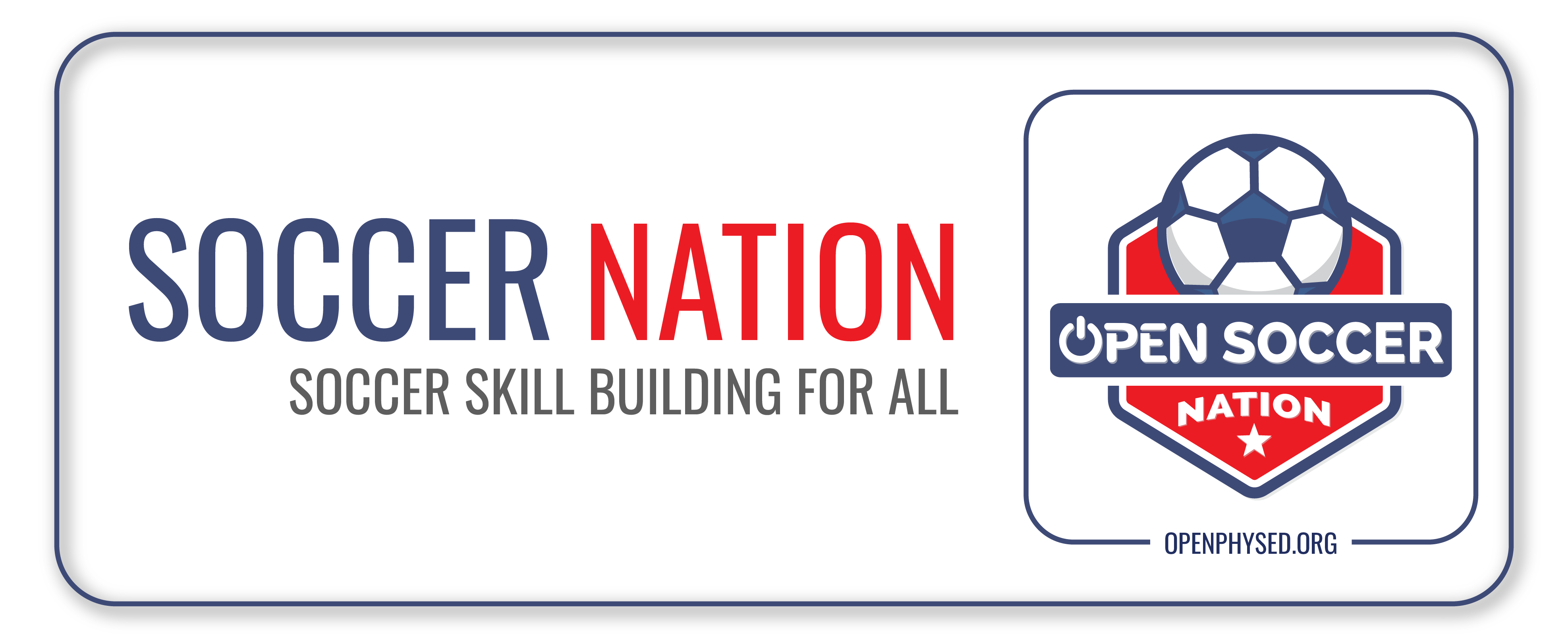
OPEN Soccer Nation – High School Physical Education
Challenge students to develop basic soccer skills and talk about why they enjoy being physically active!
This module was built to help students learn and practice soccer dribbling and passing in a virtual or in-person instructional setting. This requires all students to have a soccer ball. Schools with the budget for additional soccer balls can buy with OPEN Power Pricing and receive 50% our rubber MacGregor Soccer Balls ( coupon here ). Or, students can use this YouTube video to learn how to make an at-home soccer ball out of a hooded sweatshirt.
- Hoodie-Ball Folding Tutorial on YouTube
Grades 9-12
- Complete Packet w/Free Login [ PDF Packet ]
- Soccer Nation YouTube Playlist [ YouTube Link ]
9-12 Unlocked Resources:
- Learning Target Overview [ PDF , WORD ]
- Student Checklist [ PDF , WORD ]
- Weekly Targets [ PDF , WORD ]
- Week 1 Menu Board [ PDF , WORD ]
- Week 2 Menu Board [ PDF , WORD ]
- Week 3 Menu Board [ PDF , WORD ]
- Week 4 Menu Board [ PDF , WORD ]
- Week 1 Sample Teacher Talk [ PDF , WORD ]
- Activity Station Cards [ PDF , WORD ]
- Module Choice Board [ PDF , WORD ]
- PE Vocabulary Cards [ PDF , WORD ]
- Discussion / Journal Prompts [ PDF , WORD ]
- SEL Concept Cards [ PDF , PPT , Google ]
- Weekly Activity Logs [ PDF , WORD ]
- Dribble / Pass Skill Cues [ PDF , WORD ]
- Universal Design Chart [ PDF , WORD ]
Video Quick Links
Ted Talk Videos used with SEL Concept Cards :
- Self Care: What It Really Is [ Video Link ]
- All it takes is 10 mindful minutes [ Video Link ]
- Grit: The power of passion and perseverance [ Video Link ]
- Want to be happy? Be grateful! [ Video Link ]
Learn more about Believe In You SEL resources at www.believeinyou.com

IMAGES
VIDEO
COMMENTS
How to Teach Soccer. When teaching Soccer in Physical Education lessons, it is helpful to have a range of activities, teaching models and styles in the toolbox to help ensure students make great progress. Soccer lessons can be delivered in a range of ways depending upon the age, group size, resources available and your level of knowledge of the ...
This Soccer for Success school curriculum was created as a resource for physical education and health education teachers to introduce the fundamentals of soccer while building critical physical, social, and emotional health skills in students.
Here are some teaching tips and activities that I've found helpful when deciding how to teach my soccer unit in Physical Education.
OPEN Soccer Nation – Elementary School Physical Education. Challenge students to develop basic soccer skills and talk about why they enjoy being physically active! This module was built to help students learn and practice soccer dribbling and passing in a virtual or in-person instructional setting. This requires all students to have a soccer ...
For physical education teachers, the sport of soccer provides a perfect opportunity to get students active and engaged in their learning. Incorporating soccer lead-up games into your lesson plan is a fun way to help students improve their skills while keeping them active.
Soccer Skills. (Intermediate 3-5) This module builds on the skills introduced in Primary Foot Skills module through skill-specific soccer lead up games. Ball control with the feet as well as dribbling, passing, and kicking in combination are the primary skills emphasized.
In the Full Soccer Pack by the PE Project you will find: Soccer activities; Skill Cards; Assessment Criteria for Elementary, Middle-School, and High-School; Soccer Considerations; Non-doer sheets; Plus lots of additional extras like questions, teaching recommendations, differentiation strategies.
In The Full Soccer Pack by the PE Project you will find: Soccer activities; Skill Cards; Progressions; Assessment Criteria for Elementary, Middle-School and High-School; Soccer Considerations; Plus lots of additional extras like questions, teaching recommendations, differentiation strategies.
OPEN Soccer Nation – High School Physical Education. Challenge students to develop basic soccer skills and talk about why they enjoy being physically active! This module was built to help students learn and practice soccer dribbling and passing in a virtual or in-person instructional setting.
Physical education Project- EURO CUP 2020 - Free download as PDF File (.pdf), Text File (.txt) or view presentation slides online. The UEFA Euro 2020 soccer tournament was held in 2021 across Europe due to delays from the COVID-19 pandemic.